Formula One: 1987 German GP
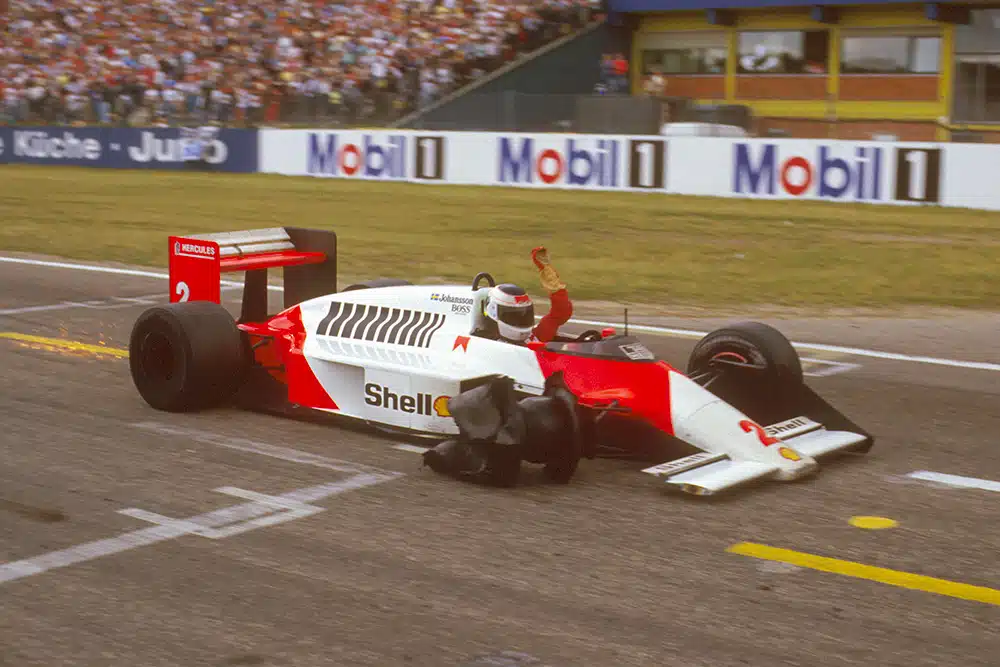
Stefan Johansson in his McLaren MP4/3 TAG Porsche finishing 2nd with only three wheels on the car.
© Motorsport Images
Attrition
My small pocket dictionary says attrition is the “act of rubbing away, to wear down”, and no more suitable word could describe what the German Grand Prix at Hockenheimring did to the Formula One entry.
We knew it was going to be fast, and we knew it was going to be hard on engines, but nobody anticipated that of the twenty-one turbocharged l½-litre cars which started, only two would be healthy at the finish, and two more were lucky to finish. If ever there was a “rubbing away” of a full Grand Prix entry, this was it. Even the non-turbo charged 3½-litre entry suffered, two of the five cars falling by the wayside with engine-related problems.
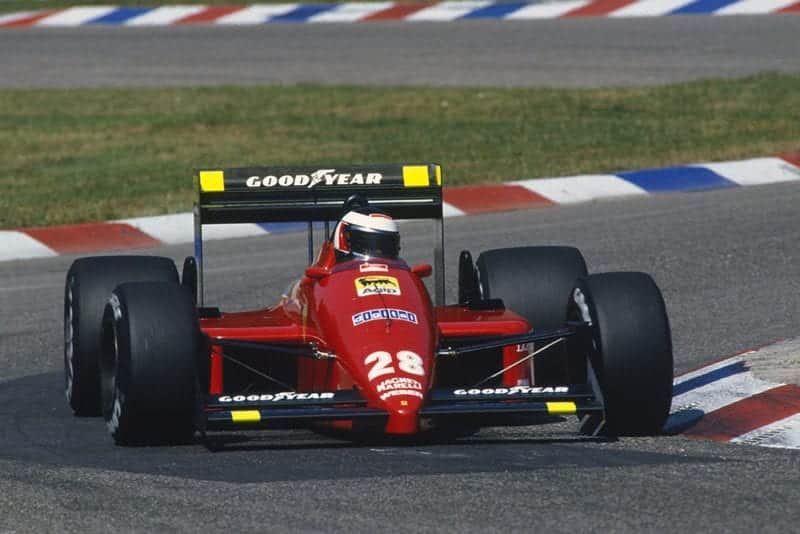
Gerhard Berger in his Ferrari F1-87.
© Motorsport Images
Had the race gone on for one more lap, the second-placed man Stefan Johansson would have been out, as his McLaren crossed the finishing line on three wheels; even the third-placed man, Ayrton Senna, had a marginal finish as his Lotus suspension had stopped being “active” and had become embarrassingly “passive”. The car was sitting down on its support springs, and his lap times were down from 1min 49sec to 2min 05sec.
Only Piquet’s winning Williams-Honda was in good health among those classified, though Martin Brundle’s Zakspeed was healthy enough, but ten laps behind and not officially classified as a finisher. The electrics on the 4-cylinder Zakspeed engine had played up, and it had taken two long pit stops to cure a misfire. When it finally got going it was too far behind to hope for a good result, but the British driver pressed on and did his last lap in 1min 49.742sec, his fastest of the whole weekend, so clearly the trouble had been cured. It was the sixth fastest lap of the whole entry in the race!
Due to the vagaries of the race rules, Alain Prost was classified 7th, even though his McLaren-Porsche was abandoned by the track-side with an engine failure.
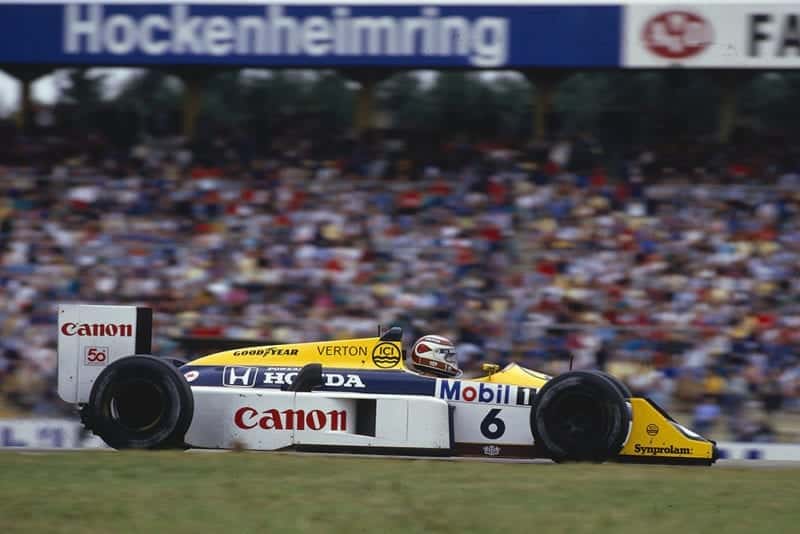
Nelson Piquet went on to win in his Williams FW11B Honda.
© Motorsport Images
This race was the mid-way point in the 1987 Formula One season, and at times we wondered if anyone was going to finish, though the race was only 185 miles long. The unsupercharged Cosworth-powered Tyrrells were healthy enough, and the only ones actually racing, but they were some five miles behind at the finish.
This mechanically devastating German GP would suggest that the going has been hard for the first half of 1987, and that would be absolutely correct. The pace of the front-runners has been such that the mid-field and the tail-enders are struggling to keep up, and the seriousness of the front-runners has meant that there has been no let-up to wait for the lame-dogs to catch up.
Although people will argue with me, I think we should thank the Honda Motor Company of Japan for bringing about this powerful advancement at the front of Formula One. Its latest turbocharged V6 is beginning to make the Porsche V6 look a bit dated; on home-ground Porsche produced some modified engines which could match the Hondas, but were not trouble-free.
Honda itself suffered engine trouble in the race, for Nigel Mansell’s engine seized up due to internal overheating, not sufficient to register a rise in coolant temperature or oil temperature, but enough to make the internal parts suffer and seize.
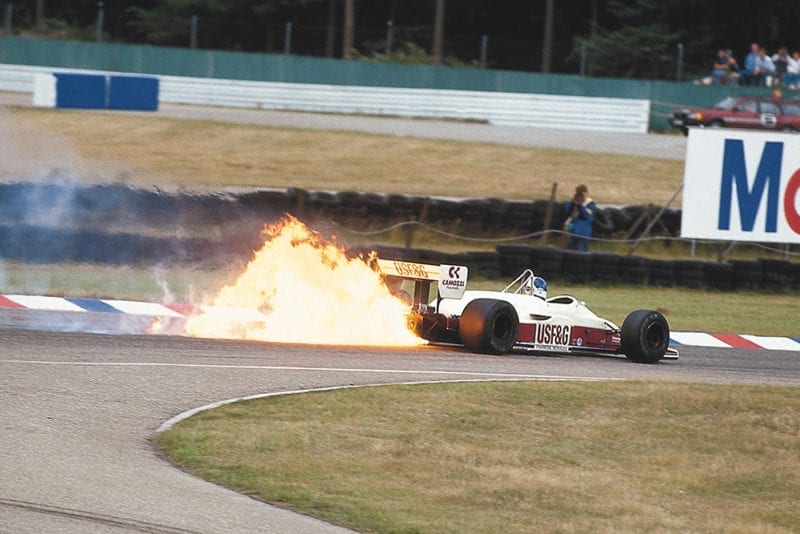
Derek Warwick’s Arrows A10 Megatron BMW catches fire.
© Motorsport Images
This suggests a slight miscalculation of mixture strength, and indicates just how “near the bone” the modern Grand Prix engine is running. Variations of all the factors affecting power output coupled to economy are microscopic, yet vital, which is why the electronics world has perfected engine management systems controlled by microchips.
The Porsche engine problem was something quite different, though exactly what it is we shall not know until Hans Mezger, the Porsche engine designer, writes a learned paper on the development of the TAG-inspired Formula One engine. Officially, according to McLaren International, Prost retired due to a broken alternator drive-belt (the third this season), but that does not begin to tell a quarter of the story. Internal-toothed drive-belts do not break on their own, they have to be provoked. If the belt is driven by a pulley on the end of a camshaft, and the camshaft stops going round very suddenly due to an internal breakage, that could break the belt; or if the camshaft is going merrily on its way and the alternator seizes up then that would break the belt. A third possibility is that the engine itself develops an out-of-balance vibration and the harmonics are transmitted to the drive pulleys or the alternator rotor, and something shatters.
It seems most likely that the Porsche engine has produced some strange internal vibrations, setting up an unsympathetic frequency somewhere along the line, and this could be a product of having to raise the limits of the engine in order to challenge the Honda. From the beginning of the Porsche engine in Formula One reliability has been the keynote. That reliability seems to have waned, and it can only be due to the fact that the Honda opposition is making the Porsche engine run really hard.
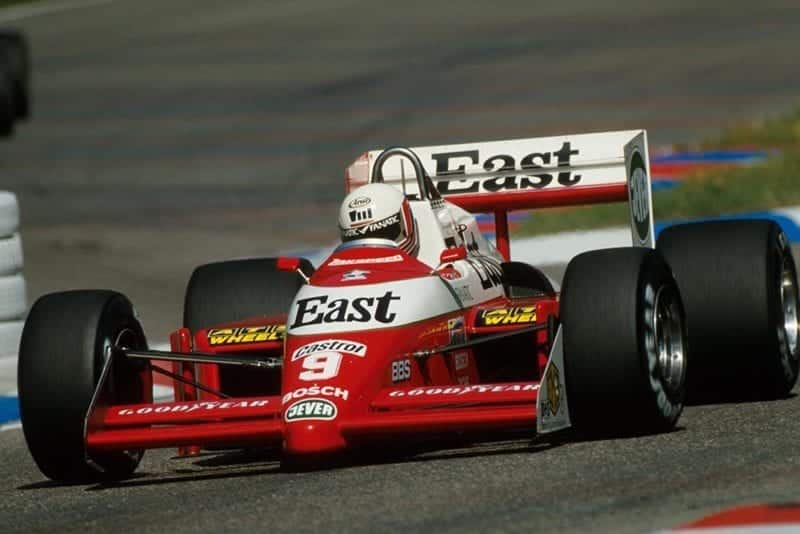
Martin Brundle did not finish in his Zakspeed 871.
© Motorsport Images
That is what racing is all about, and you can be sure that Porsche will solve the problem and learn a lot at the same time. They do not race as a PR exercise, they race as a technical exercise. Meanwhile Prost loses races, but he must have faith in McLaren and what it is doing, for he has signed up to drive for the team for the next two years.
Prost should have won the German GP, while Mansell could have won, and Piquet did win. Mansell set the pace throughout practice and claimed number one position on the starting grid, but for some unknown and undisclosed reason FISA reversed the pole position on the grid from the right to the left, and only told the drivers a couple of hours before the start. This meant that Mansell was on the left, and Senna in second place was on the right.
When the green light came on Mansell let his Honda engine go right up to the rev-limiter (11,500 rpm?) in first gear, and as he hooked second gear the engine “bogged down” momentarily and Senna was ahead and Prost was alongside the Williams; then it picked up and Mansell was away, but it meant that the yellow Lotus led the first lap.
If Mansell had been on the right of the grid, where pole position has been in the past, he would have been able to hold an inside line round the first corner and Senna and Prost would have had to go round the outside, instead of being able to dive to the inside. It did not seem to matter much, for on lap 2 Mansell powered past Senna, as did Prost, and the Lotus driver virtually gave up.
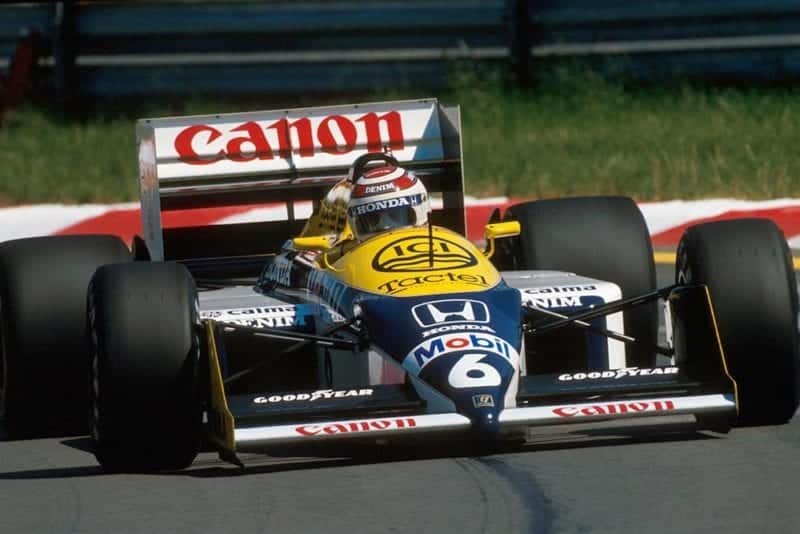
Nelson Piquet in his Williams FW11B.
© Motorsport Images
On lap 8 Prost took the lead by powering past Mansell, having leaned on the Williams for a couple of laps, and what we were seeing was car racing as distinct from driver racing. On ability to drive fast there is little to choose between Prost, Mansell, Piquet and Senna, so when you see Senna unable to keep up it must be the car which is at fault; equally, when you see Mansell unable (or unwilling) to hang onto Prost it must be a car deficiency.
The big factor in racing today is fuel consumption, though nobody quite understands why, and the cars have a panel in front of the driver giving a read-out on his fuel consumption, so that he knows at what speed he can go and still cover the 44 laps. If his consumption is too much it will tell him he will run out of fuel on lap 42, or whatever it is. Mansell could have held onto Prost but his read-out was warning him that he would not finish the race at that fuel consumption, so he had to back off and let Prost increase his lead.
Prost, meanwhile, was running comfortably within his limits and pulling out a slight advantage over the Williams. Piquet, on the other hand, hardly knew where he was, for his read-out had gone on the blink, so he hung back and merely kept the leaders in sight. That Senna could not keep pace with them was another matter altogether.
Using a similar engine to the Williams duo (and when Honda says all its engines are equal, you have got to believe it), the Lotus 99T does not seem to be able to match the Williams FW11B. The one thing in the equation that can be discounted is driver ability, for Senna has proved he is the equal of anyone; so where is he losing out?

2nd placed Stefan Johansson at the wheel of his McLaren MP4/3.
© Motorsport Images
Clearly the Lotus is not utilising the Honda horsepower as well as the Williams is, and that could be in one of two main areas. Either the chassis and suspension are not transmitting the power to the road as effectively, or the car is not as aerodynamically efficent, and some of the power is being wasted in overcoming drag rather than propelling the car. The Williams aerodynamicist, Frank Dernie, says emphatically that his car is aerodynamically more efficient than the Lotus (he would, wouldn’t he?), and therefore it can utilise the Honda engine’s power in a more fuel-efficient manner.
He is probably correct, for during practice and qualifying the Lotus engineers cribbed an aerodynamic tweak off the Williams, and Senna nearly claimed pole position. If it had not rained heavily on Saturday, he might well have been on pole. But qualifying and racing are two very different technical games, and at the moment Patrick Head and his engineers in the Williams team seem to have the upper hand, as far as utilising Honda power is concerned.
Another factor in the Williams/Lotus equation is the Lotus hydraulic, computer-controlled suspension, which it calls “Active” for want of a better word, but which others prefer to call “Rapid Response Self Levelling System” and some engineers think it is not “rapid” enough. If it is any sort of advantage at all, then with Senna’s known ability it ought to put the car well ahead, all other things being equal. However, we know that all other things are not equal, certainly as regards using the Honda engine fuel-efficiently, so it looks as though a Lotus 99T without its active-suspension would be a real dog.
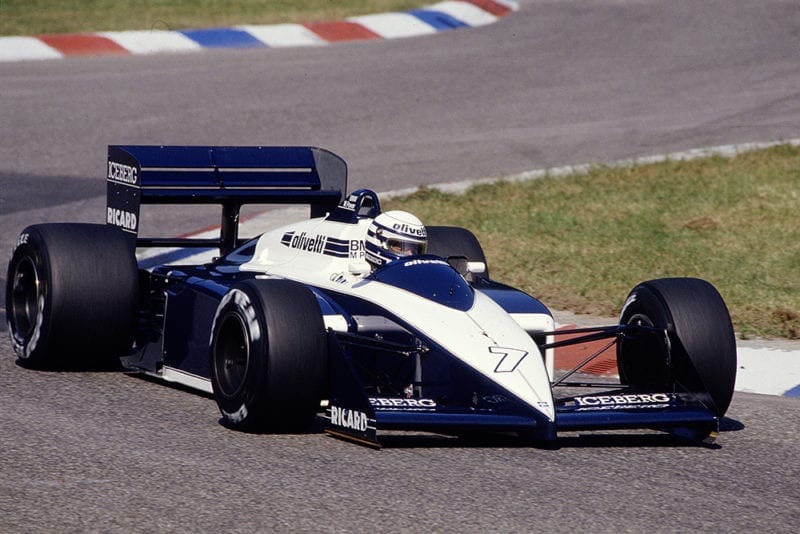
Riccardo Patrese driving his Brabham BT56 BMW.
© Motorsport Images
All the Lotus team cars have been fitted with the system, in which hydraulic rams control the suspension movement, and small coil-springs merely hold the car up when the engine and hydraulic pump are not working. Lotus has been racing with this system all season, and though there have been minor problems, there have never been any real failures, but this time both cars suffered failures in the hydraulics system.
Saturo Nakajima was out after only 10 laps, when something went wrong in the system and the car “wobbled” diagonally in an uncontrolled fashion. Near the end of the race Senna’s car had an oil union crack, which leaked the oil out of the hydraulic system and let the car sink down onto its support springs and virtually rub along the ground — so he was lucky to finish.
While Prost should have won, Mansell could have won, and Piquet actually won, Senna never had a hope of winning, which he knew full well on the second lap. He had been forced to change cars on the “dummy-grid”, for his race car seemed to be down on power on his warm up laps after the pit lane was opened.
He abandoned the car at the back of the grid, and walked up to the front, where the Lotus mechanics had the T-car all ready and waiting for him. Even if he knew he could not match the Honda and Porsche engines in race conditions, it did not stop him making a screamer of a start and snatching the lead for one glorious lap. That is what we call the “racer instinct”.
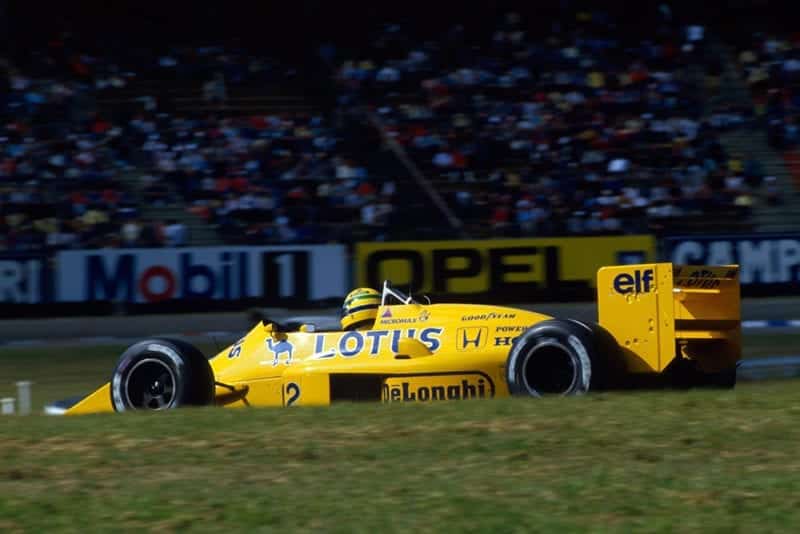
Ayrton Senna in his Lotus 99T.
© Motorsport Images
Of all the other drivers in the race none had any hope of winning, unless the top four fell by the wayside. This time three of them did, but so did most of the also-rans, and the Tyrrell twins almost came through into the picture, from their private race down in the normally-aspirated class.
This second category, which appeared in Formula One this year, is supposed to be heralding the new formula which comes into effect in 1989, when turbocharging is banned. It is for 31/2-litre-engined cars, without turbocharging or supercharging, and the idea was to allow engine manufacturers to introduce a new engine programme over two years, instead of over just one winter.
It was never intended to give the kiss-of-life to the “vintage” Cosworth V8, but so far that is all it has done. It has allowed teams such as Tyrrell, which got dropped from the turbo-charged race, to stay in Formula One, and has encouraged March, Lola and AGS to join in the game. But as a foretaste of Grand Prix racing in 1989, all I can say is “I think I’ll take up model car collecting”. However, all is not lost, for there are signs on the horizon that we could be in for something interesting. Honda has let it be known that it has a V10 (yes vee-ten) cylinder engine well under way, and already Williams is working on a prototype car; and you can rest assured that the engine men at Maranello have been looking through their old notebooks about unblown engines. We might even see signs of a new Ferrari engine about Monza time, and one wonders what Porsche is doing at Weissach.
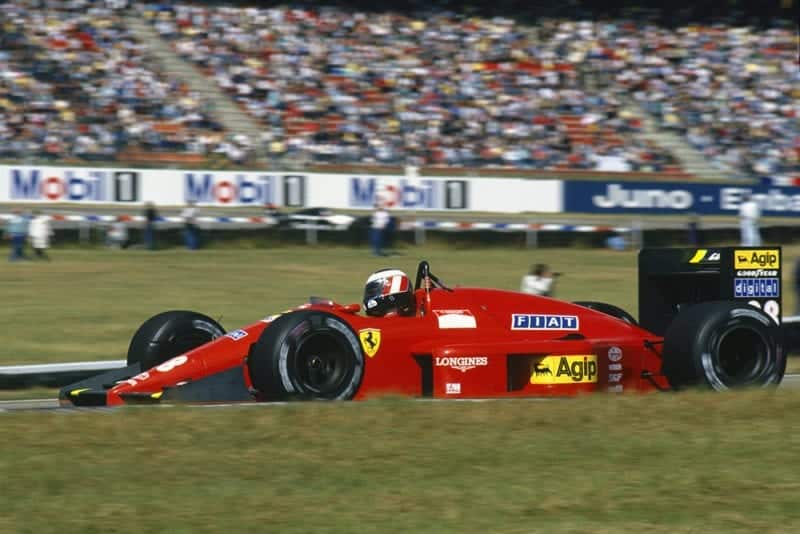
Gerhard Berger in his Ferrari F1-87.
© Motorsport Images
In the meantime, the five Cosworth-powered cars at the back of the grid (and sometimes near the front of the results) are enjoying their own little scene and trying not to get in the way of the fast cars. The mid-field runners, who cannot hope to keep up with the big factory teams, are already making noises about joining the Cosworth-powered cars, and Ligier for one is likely to appear soon with such a car.
Guy Ligier appeared to have pulled a coup at the start of the year, when he got the exclusive rights to a new turbocharged 4-cylinder Alfa Romeo engine. But the whole thing fell flat on its face and in a mad rush he switched to old-style upright BMW engines, prepared by Heini Mader’s Swiss tuning shop and financed by Megatron (part of the American finance house which sponsors the Arrows team, which naturally uses the old-style BMW engines).
Saying that you will be switching to Cosworth DFZ (the 31/2-litre version of the old DFV) is one thing, but doing it is something else, for Cosworth is very busy making money at other things, so production of engines is very limited. From all accounts, by the time these words are being read, if you have not put your money down for your 1988 supply of engines you can forget it. Even then there is no guarantee that you will get what you want, when you want it.
To return to the attrition of Hockenheimring, one team which was totally attrished (!) was Ferrari. There have been some unhappy teams over the years, but this year the Ferrari team must win the unhappiness award.
Last year was bad enough, and three major changes were made for 1987. John Barnard was wooed away from McLaren to oversee the technical side of things, Gerhard Berger was wooed away from Benetton to put sparkle into the driving side of things, and the 120-degree V6 engine was abandoned in favour of a new 90-degree V6, with a whole new car around it naturally.
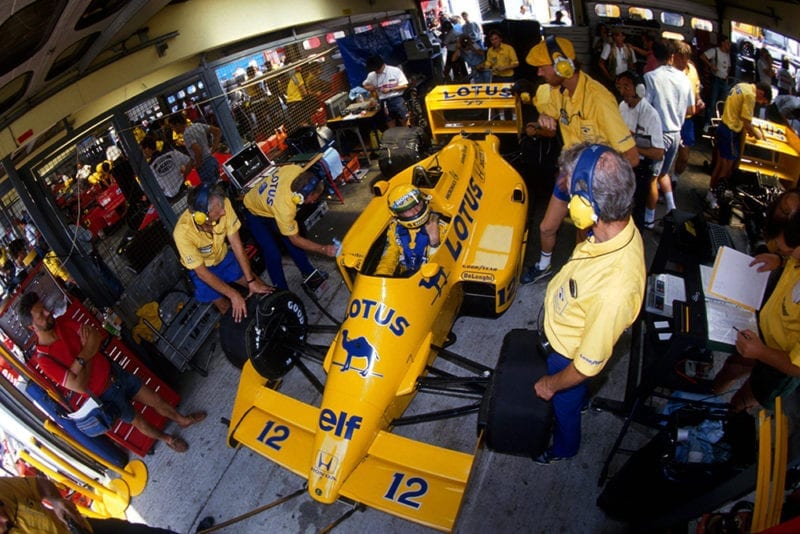
Ayrton Senna’s Lotus 99T in the pit garage.
© Motorsport Images
Nothing has improved. Barnard stood upright, proud and British, saying that if the Italians wanted to talk to him they would have to learn English, and he was not going to live in Italy; Berger has spent a lot of the season having accidents, three of them right where I happened to be standing, and the 90-degree engine has not been able to match the Honda or the Porsche.
It is not surprising that the Italian mechanics do not sing any more, and eye Barnard and his English mechanic with strange sideways looks of mistrust. One thing about an Italian mechanic is that you do not have to listen to what he says, it is written all over his face, and especially in his eyes.
To add to the Ferrari gloom, Berger’s practice accident at Hockenheimring was not his fault. It was a structural failure in the front suspension. As he put the brakes on, approaching the corner after the pits at 170 mph, the left front suspension bent and collapsed, putting him into an enormous spin which ended against the tyre barrier. It bent the car pretty badly but allowed him to step out unscathed. The fact that he then ran across the track, risking being bowled over by an approaching car, is neither here nor there.
The Italian press, which is not on Barnard’s side, really went to town in the Saturday daily papers, with great banner headlines castigating the front suspension design. If I had not seen Berger’s other two accidents, at Spa-Francorchamps and at Silverstone, and been convinced that he simply let the car get away from him, I would begin to wonder if they were not attributable to mechanical failures too.
For brief moments during the Hockenheim weekend, Alboreto looked as though he might begin to get near the front runners. But it did not last, and engine component failure put him out of the race after only 11 laps.

(L to R) 2nd place, Stefan Johansson, winner Nelson Piquet, 3rd place Ayrton Senna on the podium.
© Motorsport Images
Two other cars which went out with engine failure were the Benettons, both Ford V6 engines giving trouble. One of their problems is the fuel consumption bogey. If they run at an economy setting to finish the race they cannot keep up; if they can keep up they seem to blow up. Thierry Boutsen was holding a good fifth place in the opening stages of the German Grand Prix, but it did not last. Fabi was never in the picture.
Finally, hero of the day was Stefan Johansson, and everyone gave the cheerful Swede a heartfelt ovation. He was on the tail of the fast boys more or less from the start of the race, and worked his way up to a very sound third place, not close enough to worry Piquet in second place, but third nonetheless. With Prost retiring it meant he was in second place, and the only one on the same lap as the leader.
As he started his last lap, going down the fast section (213 mph in qualifying for the fast boys!) to the first chicane, his right front tyre deflated. He kept control and then nursed the can along slowly, trying to get the finish. When asked what “slowly” was, he grinned and said “about 150 mph”.
The McLaren came carefully into the last few corners in the stadium, with little left of the tyre, and with the suspension and steering damaged by the flailing rubber. With only one wheel steering, Johansson crossed the line in second place. This was truly hero time, and everyone was pleased for him. DSJ
